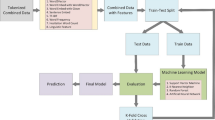Abstract
We present a new online psycholinguistic resource for Greek based on analyses of written corpora combined with text processing technologies developed at the Institute for Language & Speech Processing (ILSP), Greece. The “ILSP PsychoLinguistic Resource” (IPLR) is a freely accessible service via a dedicated web page, at http://speech.ilsp.gr/iplr. IPLR provides analyses of user-submitted letter strings (words and nonwords) as well as frequency tables for important units and conditions such as syllables, bigrams, and neighbors, calculated over two word lists based on printed text corpora and their phonetic transcription. Online tools allow retrieval of words matching user-specified orthographic or phonetic patterns. All results and processing code (in the Python programming language) are freely available for noncommercial educational or research use.
Similar content being viewed by others
References
Baayen, R. H., Piepenbrock, R., & Gulikers, L. (1995). The CELEX lexical database (CD-ROM). University of Pennsylvania, Philadelphia: Linguistic Data Consortium.
Balota, D. A., Yap, M. J., Cortese, M. J., Hutchison, K., Kessler, B.,Loftis, B., et al. (2007). The English lexicon project. Behavior Research Methods, 39, 445–459
Barca, L., Burani, C., & Arduino, L. S. (2002). Word naming times and psycholinguistic norms for Italian nouns. Behavior Research Methods, Instruments & Computers, 34, 424–434.
Chalamandaris, A., Raptis, S., & Tsiakoulis, P. (2005). Rule-based grapheme-to-phoneme method for the Greek. In Inter speech 2005 (pp. 2937–2940).
Coltheart, M., Davelaar, E., Jonasson, J. T., & Besner, D. (1977). Access to the internal lexicon. In S. Dornic (Ed.), Attention and performance VI (pp. 535–555). Hillsdale, NJ: Erlbaum.
Conrad, M., Carreiras, M., & Jacobs, A. M. (2008). Contrasting effects of token and type syllable frequency in lexical decision. Language and Cognitive Processes, 23, 296–326. doi:10.1080/01690960701571570.
Fourakis, M., Botinis, A., & Nirgianaki, E. (2003). Hroniká haraktiristiká ton simfonikón akolouthión [ps], [ts], kai [ks] stin ellinikí [Temporal characteristics of [ps], [ts], and [ks] consonant sequences in Modern Greek]. In Proceedings of the 6th international conference on Greek linguistics (ICGL6), Rethimno, Greece, September 18–21.
Gomes, I., & Castro, S. L. (2003). Porlex, a lexical database in European Portuguese. Psychologica, 32, 91–108.
Hatzigeorgiu, N., Gavrilidou, M., Piperidis, S., Carayannis, G., Papakostopoulou, A., Spiliotopoulou, A., et al. (2000). Design and implementation of the online ILSP corpus. In Proceedings of the 2nd international conference of language resources and evaluation (LREC) (Vol. 3, pp. 1737-1740), Athens, Greece.
Hofmann, M. J., Stenneken, P., Conrad, M., & Jacobs, A. M. (2007). Sublexical frequency measures for orthographic and phonological units in German. Behavior Research Methods, 39, 620–629.
Ktori, M., van Heuven, W. J. B., & Pitchford, N. J. (2008). GreekLex: A lexical database of Modern Greek. Behavior Research Methods, 30(3), 773–783.
Lambert, E., & Chesnet, D. (2001). Novlex: Une base de donneés lexicales pour les élèves de primaire. L’Année Psychologique, 101, 277–288.
Laudanna, A., Thornton, A. M., Brown, G., Burani, C., & Marconi, L. (1995). Un corpus dell’italiano scritto contemporaneo dalla parte del ricevente. In S. Bolasco, L. Lebart, & A. Salem (Eds.), III giornate internazionali di analisi statistica dei dati testuali (Vol. I, pp. 103–109). Roma, Italy: Cisu.
Lété, B., Sprenger-Charolles, L., & Colé, P. (2004). MANULEX: A grade-level lexical database from French elementary-school readers. Behavior Research Methods, Instruments, & Computers, 36, 156–166.
New, B., Pallier, C., Brysbaert, M., & Ferrand, L. (2004). Lexique 2: A new French lexical database. Behavior Research Methods, Instruments, & Computers, 36, 516–524.
Peereman, R., Lété, B. B., & Sprenger-Charolles, L. (2007). Manulex-Infra: Distributional characteristics of grapheme-phoneme mappings, infra-lexical and lexical units in child-directed written material. Behavior Research Methods, 39, 579–589.
Petrounias, E. V. (2002). Neoellinikí grammatikí kai sigkritikí análisi, tómos A: Fonitikí kai eisagogí sti fonología [Modern Greek grammar and comparative analysis, Vol A: Phonetics and introduction to phonology]. Thessaloniki: Ziti.
Protopapas, A. (2006). On the use and usefulness of stress diacritics in reading Greek. Reading & Writing: An Interdisciplinary Journal, 19(2), 171–198.
Protopapas, A., & Vlahou, E. L. (2009). A comparative quantitative analysis of Greek orthographic transparency. Behavior Research Methods, 41, 991–1008
Revithiadou, A. (1999). Headmost accent wins: Head dominance and ideal prosodic form in lexical accent systems. LOT Dissertation Series 15 (HIL/Leiden University). The Hague: Holland Academic Graphics. (Available from http://www.roa.rutgers.edu)
Rinaldi, P., Barca, L., & Burani, C. (2004). A database for semantic, grammatical and frequency properties of the first words acquired by Italian children. Behavior Research Methods, Instruments & Computers, 36, 525–530.
Selkirk, E. (1984). Phonology and syntax: The relation between sound and structure. Cambridge, MA: MIT Press.
Spencer, K. A. (2009). Feedforward, -backward and neutral transparency measures for British English. Behavior Research Methods, 41, 220–227.
Spencer, K. A. (2010). Predicting children’s word-reading accuracy for common English words: The effect of word transparency and complexity. British Journal of Psychology 101(3), 519–543. doi:10.1348/000712609X470752.
Tzakosta, M., & Karra, A. (2007). A typological and comparative account of CL and CC clusters in Greek dialects. In 3rd International conference on Modern Greek dialects and linguistic theory, University of Cyprus, June 14–16.
Tzakosta, M., & Vis, J. (2007). Phonological representations of consonant sequences: the case of affricates vs. ‘true’ clusters. In 8th International conference on Greek Linguistics, University of Ioannina, August 30–September 2.
Yarkoni, T., Balota, D., & Yap, M. (2008). Moving beyond Coltheart’s N: A new measure of orthographic similarity. Psychonomic Bulletin & Review, 15(5), 971–979.
Acknowledgments
We thank Despina Paizi for information on Italian databases and Eleni Orfanidou for comments on the manuscript.
Author information
Authors and Affiliations
Corresponding author
Rights and permissions
About this article
Cite this article
Protopapas, A., Tzakosta, M., Chalamandaris, A. et al. IPLR: an online resource for Greek word-level and sublexical information. Lang Resources & Evaluation 46, 449–459 (2012). https://doi.org/10.1007/s10579-010-9130-z
Published:
Issue Date:
DOI: https://doi.org/10.1007/s10579-010-9130-z




